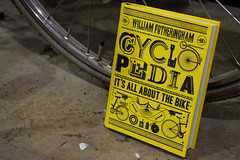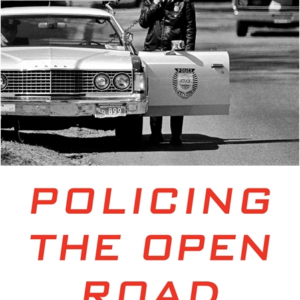When a book says it’s “all about the bike” and proudly displays images of disassembled bike components on its cover I assume it will eventually be sitting on a shelf in my garage, close to a pedal wrench and a bottle of chain lube.

William Fotheringham’s Cyclopedia from Chicago Review Press is far from the repair manual its cover makes it look like. The book also is not a dry compendium as the word “cyclopedia” might imply.
Instead, it’s a deep dive into the rich knowledge of Fotheringham, built on his over 30 years of experience reporting on professional cycling. While the book includes plenty of technical information, the entries are grounded in historical context.

Cyclopedia‘s entry for “gears” is longer than most other sections of the book and goes into detail about the evolution of gearing on bicycles, from the first fixed-gear high-wheeler to the modern derailleur. Basic mechanics of each type of gearing is described and Fotheringham frames each development in technology by the events of the day.
Fotheringham weaves together information about racing’s politics and bicycle mechanics to paint a picture of what it was like to ride on the bikes he describes.
“In 1936, Henri Desgrange stepped down as Tour de France organizer, and the way was open for the use of geared bikes in the race from 1937; until then, the riders had used wheels with two sprockets on either side; to change gear they would stop, take their rear wheel out, and turn it around.”
At the same time, the section on gearing also shows Cyclopedia‘s limitations.
Although racing bikes are described in detail, Fotheringham stops short of talking about how changes in race technology permeated out to the everyday rider. Technology not used in racing is left out completely (there’s no mention of internal hub gears or twist-shifters, for instance).
Fotheringham himself acknowledges the book’s limitation in the preface, explaining that he “cannot help but reflect [his] personal views on a world in which [he has] been immersed for two-thirds of [his] life.”
“… before discussing the World Naked Bike Ride, Fotheringham explains that nude cycling was
‘first depicted, perhaps, in an 18th-century English church window.'”
It’s understandable that an author will project their personal experience through their writing and Fotheringham’s personal experience makes Cyclopedia an enjoyable book to read (as long as you’re not looking for something unrelated to professional cycling).
Drawing on his own knowledge allows Fotheringham to keep Cyclopedia free from the clutter of citations and references that can make some reference books seem dry. He included a bibliography at the end of the book but lists only nine publications as sources.
In place of citations, Fotheringham make sure communicates how certain he is about the facts he’s conveying. As an example, before discussing the World Naked Bike Ride, Fotheringham explains that nude cycling was “first depicted, perhaps, in an 18th-century English church window.”
Casual language, narrative historical accounts, and easily digestible technical descriptions all make Cyclopedia a reference book that you can read from front to back like a novel.
In fact, reading Cyclopedia reminds me of what it might be like to sit down with Fotheringham over a pint while I throw out different topics and listen to him discuss all that he knows. Who wouldn’t want to spend an evening doing that?





Oi, hey, citations are good! As long as th writer and publisher know what they’re doing, and make the footnotes or endnotes clean and accessible.